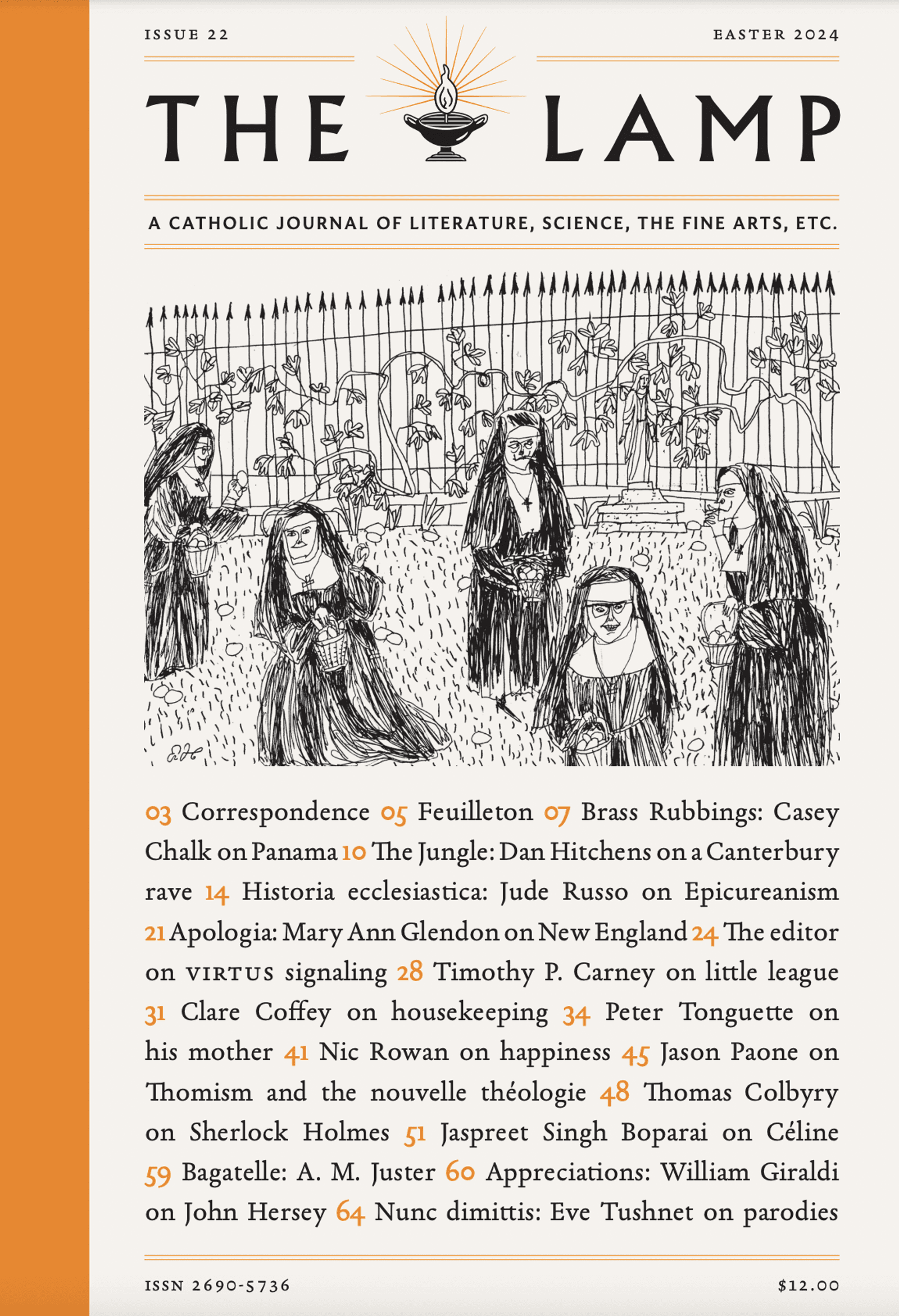In college I went to a church where the homilies often felt like they should come with footnotes. The Dominican priests presented the fruits of their study in careful, sometimes soporific cadence. And then there was Father H. Father H. was short and stocky and hard of hearing (confessions with Father H. were quite comforting, right until he began advising you at full volume), and he preached about his childhood. In a hoarse voice, age blurring his accent until it could have come from anywhere north of New Jersey, he regaled us with stories of a pre–Vatican II neighborhood where the Church was the only world children knew, and so the site of all their encounters with the world’s duplicity and joys. As a new convert, I was enthralled. Mother’s sodality meetings, Father leading the nightly family Rosary, the feeling that the Church is irrepressibly, ridiculously, indefatigably everywhere—how exotic!
John Bellairs’s slim little volume St. Fidgeta and Other Parodies came out in 1966, a year like a door swinging open from Father H.’s world onto ours. Chapter headings include such Frost in May confections as “A Chaplet of Devotions, Causes, and Societies to Which the Catholic May Safely Adhere” and “The Moist Heart: A Compendium for Private or Public Worship.” Catholics in this book subscribe to the Sunday Intruder and seek advice from books like The Topless Bathing Suit and the Bottomless Pit or So You Think Chastity Is a Joke! Bellairs’s Catholic world is confident and combative, and cozy; strict and stupid, and beloved. And it felt unexpectedly familiar. Maybe today much more than when I entered the Church in 1998, self-consciously Catholic Americans are living not in 1966 but in a parody version of it. If parody is our lot, at least St. Fidgeta suggests the parody can be a fond one.
St. Fidgeta covers every modern Catholic literary genre. There’s hagiography: “We see Floradora, her glossy aureate curls shining in the crisp Italian sunlight, scattering the tinkling denari. . .” There’s political pamphleteering, Cold War in specifics but utterly familiar in general outline: an obstreperous nun waves “a Viet Cong flag,” and Bill Buckley threatens to seed a papal audience with fans of capitalism. There are prayers (“For the Speedy Demise of a Bishop”) and advertisements (“Jacques Maritain says ‘Try Pepsi-Cola, the drink that is’”). There’s advice: “In the first place, you have to make nine First Fridays. You don’t get anything for five.”
And, of course, there’s apologetics. For example, we must acknowledge the Bad Popes: “The worst Pontiff ever to slouch menacingly in a corner of the Chair of Peter was Spatulus III (898–899), who came to power as the nerveless ninth century was dissolving imperceptibly into the tepid tenth.” But as every well-catechized Catholic knows, even the bad popes prove the power of the Holy Spirit working in the Church: “The thing to remember about these ‘Bad’ Popes is that they proclaimed no ex cathedra doctrines.”
John Bellairs shaped my childhood through his later career as an author of children’s Gothic mysteries. Illustrated by Edward Gorey, another master of moppet macabre, these spooky little novels portrayed the Catholic Church as the source of good magic to combat sorcery, rapacity, and general rottenness. When I first heard the Litany of Loreto, I realized, “That’s the weather-wizard puzzle from The Dark Secret of Weatherend!” When I lived in a cockroach-infested apartment sometime in the terrible think-tank years, I would come home to a door covered in scuttling little horrors and think, “It is getting way too Curse of the Blue Figurine up in here.” Bellairs’s children’s novels show the same ironies as his parody volume, and the same glee in the collision of ancient mystery with modern consumer culture. That blue figurine is a faux Egyptian tomb guardian, a souvenir from Cairo, Illinois—but the curse is no less real for all that.
And just as St. Fidgeta could only be written by a believing Cat’lick, so the Gothic novels wear their morality lightly because the Catholic moral world is the only one imaginable. Bellairs is not constructive or well-intentioned. He’s not a teacher but a friend—to anxious children, misfit adults, bearded weirdos and spinsters, supercilious lawyers and superstitious priests. All of them Catholic, their faith unquestioned and undefended, marbled with half-understanding and pierced by mystery. The faith on display in St. Fidgeta is less eerie, more pushily rational. For that reason its delectable human folly is more evident.




